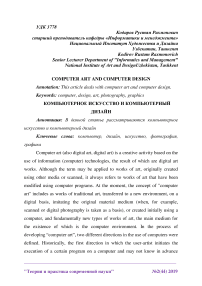Computer art and computer design
Автор: Kodirov R.R.
Журнал: Теория и практика современной науки @modern-j
Рубрика: Основной раздел
Статья в выпуске: 2 (44), 2019 года.
Бесплатный доступ
This article deals with computer art and computer design.
Computer, design, art, photography, graphics
Короткий адрес: https://sciup.org/140274321
IDR: 140274321
Текст научной статьи Computer art and computer design
Computer art (also digital art, digital art) is a creative activity based on the use of information (computer) technologies, the result of which are digital art works. Although the term may be applied to works of art, originally created using other media or scanned, it always refers to works of art that have been modified using computer programs. At the moment, the concept of "computer art" includes as works of traditional art, transferred to a new environment, on a digital basis, imitating the original material medium (when, for example, scanned or digital photography is taken as a basis), or created initially using a computer, and fundamentally new types of works of art, the main medium for the existence of which is the computer environment. In the process of developing “computer art”, two different directions in the use of computers were defined. Historically, the first direction in which the user-artist initiates the execution of a certain program on a computer and may not know in advance what the result will be. Here the computer generates (generates) images and actually acts as a “creator”. The first works of this area of computer art were created in the early 50s of the twentieth century by an American mathematician and artist Ben Laposki, who, in his spare time from electro physical experiments, began to create compositions called “Electronic Abstractions” (or “oscillons”, “Oscillons”) with the help of a cathode ray tube (CRT) oscilloscope [7]. Later on, the obtained images were recorded on a high-speed film. Creating "electronic abstractions" Laposki called "visual music." The phenomenon of this area of computer art attracted the attention of scientists and in 1968, George Nies was defended at the Max Bens Institute (Stuttgart, Germany) and his first thesis in this field, Generative Computer Graphic (Generative Computer Graphics). Max Bens called this new trend “künstliche Kunst” (“artificial art”) [8].The second direction assumes that the artist uses a computer as a universal tool that combines the functions of a palette and a canvas. When solving complex creative design problems, these two approaches are often used at the same time, making it possible to combine the artist's skill and computer effects in one project. This area is usually called computer graphics. The beginning of the era of computer graphics has been counted out since 1963, when Ivan Sutherland presented a program for interactive work with computer graphics Sketchpad at the Fall Joint Computer Conference conference, which was designed to draw with a special light pen on the surface of the monitor screen, which practically the first time allowed the artist to draw using a computer. In the early 1960s, American artist Charles Zuri created his first works in the field of computer graphics.In 1971, Herbert Frank publishes in Germany the first book on computer art “Computer graphics - computer art (“ Computer Graphics – Computer Art ”). In 1988, the First International Symposium on Electronic Art was held in Utrecht (Germany). In 1992, the first Digital Salon (digital salon) was opened in New York (USA). In 1995, the first CADE conference was held in Brighton (UK). And finally, in 1998, Wolfgang Lizer founded the Museum of Digital Art, which can be considered a full recognition of computer art as an art form. We define computer design as a design area in which a computer is used as the main tool for artistic design and design, or, with some assumptions, is to use computer graphics for design purposes. The key concept defining this type of artistic creativity in the phrase “computer design” is the concept “design”. With the emergence and development of computer graphics, artists-designers were among the first to use it in their work, and computer design is currently used in almost all areas of design.
Modern computer programs not only reduce the time spent on the project, but also significantly expand the palette of graphic and technical capabilities of the designer. For this purpose, special design packages of art-graphic and engineering-design programs, including three-dimensional graphics and animation, have been created. Specialized design programs can sometimes replace an army of related specialists. They not only carry out accurate calculations, determining the shape of the product, suggesting the choice of various structures and materials, but also allow in a three-dimensional image and in real time to model the future object in various situations, not only to create virtual images of the shape of the designed object and check its functioning including in extreme conditions.
Список литературы Computer art and computer design
- Ostanin, A.A. Design, computer design: cultural interpretation: author. dis. Cand. cultural studies. science: 24.00.01 / A.A. Ostanin; Mosk. ped. state un-t - M., 2004. - 16 p.
- Turlyun, L.N. Computer graphics as a special kind of modern art: abstract. dis. Cand. art historian: 17.00.04 / L.N.Turlyun; Alt. state un-t - Barnaul, 2006. - 23 p.


